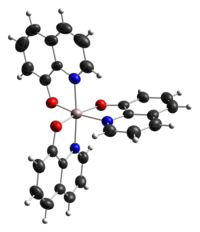Tris(8-hydroxyquinoléine)aluminium(III)

| Tris(8-hydroxyquinoléine)aluminium(III) | |
 Structure du tris(8-hydroxyquinoléine)aluminium(III) | |
| Identification | |
|---|---|
| Nom UICPA | tri(quinoléin-8-yloxy)alumane |
| Synonymes | tris(quinoléine-8-olate) d'aluminium, |
| No CAS | |
| No ECHA | 100.016.570 |
| No CE | 218-227-0 |
| PubChem | 16683111 |
| SMILES | |
| InChI | |
| Apparence | poudre jaune |
| Propriétés chimiques | |
| Formule | C27H18AlN3O3 [Isomères] |
| Masse molaire[1] | 459,431 7 ± 0,024 4 g/mol C 70,59 %, H 3,95 %, Al 5,87 %, N 9,15 %, O 10,45 %, |
| Propriétés physiques | |
| T° fusion | 413-415 °C |
| T° ébullition | > 425 °C |
| Solubilité | insoluble dans l'eau |
| Précautions | |
| SGH[2] | |
| H315, H319, H335, P261 et P305+P351+P338 | |
| Unités du SI et CNTP, sauf indication contraire. | |
| modifier | |
Le tris(8-hydroxyquinoléine)aluminium(III), généralement abrégé en Alq3, est un complexe de formule Al(C9H6NO)3 formé d'un cation d'aluminium(III) Al3+ chélaté par trois anions de 8-hydroxyquinoléine C9H6NO−.
La dénomination de ce chélate peut varier au gré des articles publiés dans la littérature anglophone et francophone, les plus courantes étant tris(8-hydroxyquinolinato)aluminium et aluminum tris(8-hydroxyquinolinate) en anglais.
Les isomères méridionaux mer-Alq3 et faciaux fac-Alq3 ont été identifiés, ainsi que plusieurs polymorphes[3] :
 |  |
| Structure du mer-Alq3[4] | Structure du fac-Alq3[5] |
L'Alq3 est une substance couramment utilisée dans les diodes électroluminescentes organiques (OLED), les différents substituants sur le noyau quinoléine permettant de moduler la luminescence du composant[6]. On prépare l'Alq3 en faisant réagir des sources d'aluminium(III) et de 8-hydroxyquinoléine[7] :
Notes et références
[modifier | modifier le code]- Masse molaire calculée d’après « Atomic weights of the elements 2007 », sur www.chem.qmul.ac.uk.
- SIGMA ALDRICH
- (en) Michael Cölle, Robert E. Dinnebier et Wolfgang Brütting, « The structure of the blue luminescent δ-phase of tris(8-hydroxyquinoline)aluminium(III) (Alq3) », Chemical Communications, no 23, , p. 2908-2909 (lire en ligne)
DOI 10.1039/B209164J - (en) M. Brinkmann, G. Gadret, M. Muccini, C. Taliani, N. Masciocchi et A. Sironi, « Correlation between Molecular Packing and Optical Properties in Different Crystalline Polymorphs and Amorphous Thin Films of mer-Tris(8-hydroxyquinoline)aluminum(III) », J. Am. Chem. Soc., vol. 122, no 21, , p. 5147-5157 (DOI 10.1021/ja993608k)
- (en) M. Rajeswaran, T. N. Blanton et K. P. Klubek, « Refinement of the crystal structure of the δ-modification of tris(8-hydroxyquinoline)aluminum(III), δ-Al(C9H6NO)3, the blue luminescent Alq3 », Z. Kristallogr. NCS, vol. 218, , p. 439-440 (lire en ligne)
- (en) Victor A. Montes, Dr. Radek Pohl, Prof. Joseph Shinar, Prof. Pavel Anzenbacher Jr., « Effective Manipulation of the Electronic Effects and Its Influence on the Emission of 5-Substituted Tris(8-quinolinolate) Aluminum(III) Complexes », Chemistry – A European Journal, vol. 12, no 17, , p. 4523-4535 (lire en ligne)
DOI 10.1002/chem.200501403 - (en) Ryo Katakura et Yoshihiro Koide, « Configuration-Specific Synthesis of the Facial and Meridional Isomers of Tris(8-hydroxyquinolinate)aluminum (Alq3) », Inorganic Chemistry, vol. 45, no 15, , p. 5730-5732 (lire en ligne)
DOI 10.1021/ic060594s
